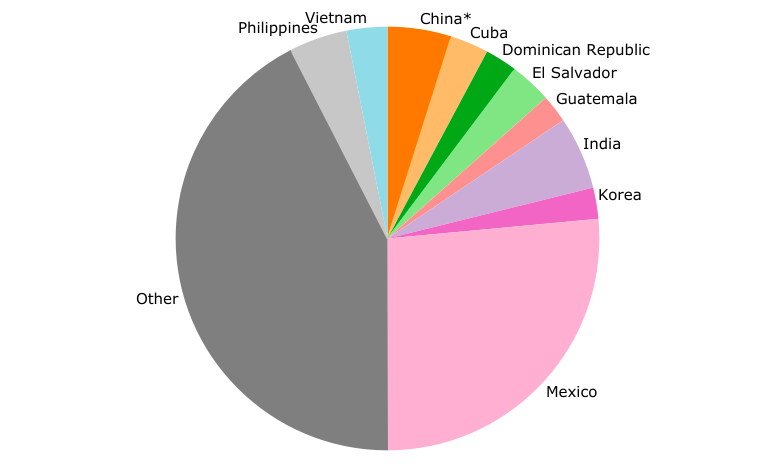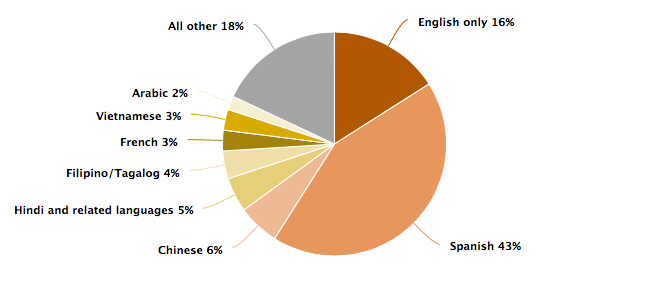What makes a person feel like an “American”? Is it baseball, apple pie, double cheeseburgers, or does it go deeper? This question is particularly important for immigrants to the United States. Once known as a melting pot of cultures, America’s immigration policy has been broadcasted to the world like never before and has polarized its citizens. Feeling “American” for immigrants is not just based on their view of themselves; it is heavily impacted by the treatment they receive from others and the expectations of the American public. This issue of feeling “American” has landed in the public eye and become a conversation topic in both social circles and academic ones. The article “Immigrant Perceptions of U.S.-Born Receptivity and the Shaping of American Identity” delves into what contributes to being “American”.
The article begins with describing different ascriptive characteristics–such as religion, ethnicity, or language– that influences an immigrant’s likelihood of naturalization or returning to their home country. To get a further view of what U.S.born individuals believe, the researchers reviewed past surveys that, “…asked respondents about what elements constitute being a ‘true’ American”. A general respect for the Constitution and laws in general were deemed important, but speaking the English language was too. Earlier work found that certain ethnic groups are perceived as more American, specifically European Americans. This result seems to suggest that, “… linking of American identity to a set of ascriptive characteristics privileging whiteness leads to an implicit (and sometimes explicit) ranking of the U.S. born over the foreign born, U.S. citizens over noncitizens, and European immigrants over their non-European counterparts” . The U.S. born may have trouble viewing immigrants as American if they lack the ideals the country’s inhabitants knowingly or unknowingly have: Christianity, whiteness, and ability to speak English. Recent immigrants that do not fit this mold may have trouble viewing themselves as truly American, along with the individuals facing discrimination. The legal status of immigrants holds a lot of power in being perceived as American, and the authors of the article found evidence that, “Undocumented immigrants, for example, are consistently viewed more negatively in public opinion polls than their legal counterparts”. Therefore, illegality can be counted as a negative characteristic on immigrants that adds to their hostile reception.
After reading studies similar to the one they were performing, the social scientists began their research. The article asserts that positive receptivity from the U.S. born plays a major role in whether an immigrant identifies themself as American, doubling as an offset to the possible clashing of ascriptive characteristics. Studies on immigration focus on law and policy based on a general public feeling, rather than individual interaction, though the researchers commented, “This is surprising, as there is considerable evidence that individual-level contact—defined as face-to-face interactions between members of different groups—can meaningfully contribute to improving intergroup attitudes”. The research suggests that if immigrants perceive their interactions with the U.S. born as positive and welcoming, it increases their chances of feeling “American”.
The researchers chose to study immigrants from Mexico and India in the metropolitan areas of Philadelphia, Pennsylvania, and Atlanta, Georgia. Mexicans and South Asian Indians are the largest group of immigrants in America, and represent stereotypically low status and high status groups, respectively, in terms of finances and the social atmosphere.
Both groups have exhibited ability to “pass” as other races in context of the United States and experience prejudice and discrimination while living in the country. Due to both groups being perceived very differently by the U.S. public, immigrants from Mexico and India made good comparison groups for the study. Philadelphia and Atlanta were chosen for their populations of white and black Americans, along with the presence of Mexican and Indian immigrants. The researchers performed a series of qualitative interviews with people born in the U.S. and foreign immigrants. The interviews focused on the ways immigrants from Mexico and India perceive barriers to being seen as American, especially by religion and language. The interviews showed that Indian immigrants, or the children of Indian immigrants, were not seen as American because of skin color. A U.S. born woman cited language as the main separator from American to outsider. The results of the survey suggested ethnicity and language had more of an impact on the public than the legality or religion of the immigrant. Some of the interviews show negative interpersonal interactions between immigrants and the U.S. Born. These negative interactions may contribute to immigrants’ reluctance to consider themselves “American”.
The findings of this study support what the researchers previously thought: ascriptive characteristics shape American identity. That being said, the article shows the importance of the concept of reception to immigrants. It states, “Sociologists of immigration have long argued that a receiving country’s ‘context of reception’ shapes new immigrants’ incorporation paths and identity formation”. This concept usually is not applied to the individual level, which this article deems important. The findings demonstrate how perceptions from one-on-one interactions are important into taking on the American identity, though ascriptive characteristics still affect the process. Immigrants that are darker-skinned or do not speak English statistically are less likely to think of themselves as American. Based on the findings, religion and legal status were not as polarizing as the language barrier.
South Asian Indian immigrants and Mexican immigrants gave more importance to different groups of U.S. natives and if they felt welcome by said groups. Indian immigrants searched for acceptance from white Americans, while Mexican immigrants looked for welcoming interactions from both white and black Americans. The researchers connect this to the socioeconomic status of both groups. Personal identification as American influences both groups of immigrants to become citizens and to stay in the U.S. Ascriptive characteristics are significant factors in immigrants’ identification as American, but so are interactions with locals. Positive conversations between immigrants and the U.S. born help both groups; immigrants in feeling welcome, and U.S. citizens in removing conscious and unconscious prejudices from their way of life.
A limitation to the study is the specific groups the researchers collected data on. Gathering information only on immigrants from Mexico and India fails to fully grasp the immigrant experience in the U.S., though each individual would have his or her own story. Only getting perspectives from two cities in the United States makes it difficult to hold the results over the entire country. The study relies on making generalizations about groups of people based on limited responses, which does not give a broad picture of immigrant perceptions in the U.S., it shows immigrant perceptions in Philadelphia and Atlanta.
The United States used to be a place of refuge for immigrants escaping oppression. Now that oppression has bled through the U.S., immigrants and people seen as “different” from the white mold of an American face discrimination and hostility. Feeling welcome in the country they now live in assists immigrants to adopt the term “American”, but what does that mean? People can define being an American as whatever they want; the U.S. does not have an official language or religion, it is a place for everyone. Being an American does not have set characteristics, but more and more people see it that way.
This country has always been a country of immigrants, since the first people migrated from Asia across a land bridge. Throughout the United States’ history, each new immigrant group was hated by those born in the country. Most citizens now are the products of these past immigrants, and think of their ancestors in high esteem, while putting down the people who join the country now. Instead of judging immigrants because of their differences, celebrate what unites us all. Love of family, love of friends, and love of country help shape the United States. Being in this country should not put entire groups of people in fear. The ethnocentric view a lot of Americans have adopted is damaging to the country and to the people themselves. The culture the United States has today is not one dimensional; it is a map of where we have been. Enjoy the unique culture this melting pot has and treat everyone with dignity and respect. It is up to us to keep the local interactions positive and welcoming; make America a country of love, not hate.
Works Cited:

